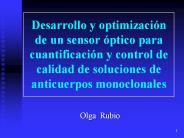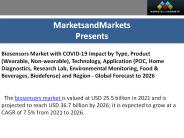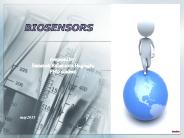Biosensores PowerPoint PPT Presentations
All Time
Recommended
Title: Biosensores Author: Mitolab Last modified by: Patricia Meade Created Date: 12/19/2001 4:56:34 PM Document presentation format: Presentaci n en pantalla
| PowerPoint PPT presentation | free to download
Title: Biosensores Author: Mitolab Last modified by: Mitolab Created Date: 12/19/2001 4:56:34 PM Document presentation format: Presentaci n en pantalla
| PowerPoint PPT presentation | free to download
... Biosensores y biochips Biotecnolog a enzim tica Biosensores Esquema de un biosensor de glucosa * * ...
| PowerPoint PPT presentation | free to download
adm@biosensores.com http://www.biosensores.com. Teofilo D ez-Caballero Arnau. Gerente ... (Master MBA y Gesti n de Sistemas, Economista) M Jesus Aracil Gomez ...
| PowerPoint PPT presentation | free to view
Bisensores y sus aplicaciones ambientales Que es un biosensor? Es instrumento para la medici n de par metros bil gicos o qu micos. Suele combinar un componente de ...
| PowerPoint PPT presentation | free to download
Desarrollo y optimizaci n de un sensor ptico para cuantificaci n y control de calidad de soluciones de anticuerpos monoclonales Olga Rubio
| PowerPoint PPT presentation | free to download
Title: Folie 1 Author: B&E Last modified by: ogni Created Date: 3/18/2005 8:34:59 AM Document presentation format: Bildschirmpr sentation (4:3) Company
| PowerPoint PPT presentation | free to view
Title: Folie 1 Author: B&E Last modified by: ogni Created Date: 3/18/2005 8:34:59 AM Document presentation format: Bildschirmpr sentation (4:3) Company
| PowerPoint PPT presentation | free to view
Title: Folie 1 Author: B&E Last modified by: ogni Created Date: 3/18/2005 8:34:59 AM Document presentation format: Bildschirmpr sentation (4:3) Company
| PowerPoint PPT presentation | free to view
Control D is a Diabetes Management kit packed in a crafted plastic box which fits inside the pocket of the patient. Control D uses advanced Amperometric Biosensors to measure accurate blood glucose using low volume of blood in 5 seconds
| PowerPoint PPT presentation | free to download
Control D is a Diabetes Management kit comes with 1 Glucometer, 1 Lancing Device, 10 Lancets, 10 Strips. Control D uses advanced Amperometric Biosensors to measure accurate blood glucose using low volume of blood in 5 seconds. Lifetime Warranty with affordable strips.
| PowerPoint PPT presentation | free to download
The term “biosensor” is short for “biological sensor.” The device is made up of a transducer and a biological element that may be an enzyme, an antibody or a nucleic acid. The bio element interacts with the analyte being tested and the biological response is converted into an electrical signal by the transducer. The emergence of nanotechnology-based biosensors, significant technological advancements in the last few years, increasing use of biosensors to monitor glucose levels in individuals with diabetes, surging demand for home-based point of care devices due to the COVID-19 pandemic, and rising government initiatives toward diagnostics are some of the factors that have supported long-term expansion for Biosensors Market.
| PowerPoint PPT presentation | free to download
According to the latest research report by IMARC Group, The global biosensors market size reached US$ 28.8 Billion in 2023. Looking forward, IMARC Group expects the market to reach US$ 55.4 Billion by 2032, exhibiting a growth rate (CAGR) of 7.3% during 2024-2032. More Info:- https://www.imarcgroup.com/biosensors-market
| PowerPoint PPT presentation | free to download
Browse Complete Summary and Table of Content @: https://www.htfmarketintelligence.com/report/global-biosensors-market
| PowerPoint PPT presentation | free to download
Smart textile is the resources that can sense and respond to the environmental or external conditions. Sensors and nanotechnology are the significant factors of the global smart textiles market. Active fabrics, passive smart fabrics and ultra-smart Fabrics are the categories of the smart textiles. The application included gadgets, smartphones, smartwatches, wristbands, wireless sensors, heart rate monitors, pedometers and motion sensors. For military and defense sector Smart textiles used in GPS trackers, helmets, wearable robots, and other equipment. IT companies are working with textiles for generating e-textiles. Also, athletes cloths having biosensors, which will help to upsurge growth in the global smart textiles market.
| PowerPoint PPT presentation | free to download
The biosensors market was valued at $17,500.0 million in 2018 and is expected to reach $38,600.2 million by 2026, registering a CAGR of 10.4% from 2019 to 2026.
| PowerPoint PPT presentation | free to download
Are you interested in the latest trends, applications, challenges, and advancements in biosensors? Join the Global Webinar on Biosensors, where researchers, scientists, doctors, practitioners, students, and industry professionals will come together to discuss the fundamentals of biosensors, the role of nanotechnology, various types of biosensors, and their applications in fields such as medical and healthcare, drug discovery, environmental monitoring, food industry, and more. The webinar will also cover topics such as wearable and implantable biosensors, immunosensors, MEMS-based biosensors, nucleic acid-based biosensors, enzyme-based biosensors, and 3D printing technologies in biosensor production. Don't miss this opportunity to acquire vital insights into this quickly growing industry and explore the newest technologies and trends that are driving growth and innovation. Register now and be part of this dynamic platform for cross-sectoral collaboration!
| PowerPoint PPT presentation | free to download
The latest report by Precision Business Insights, titled “Photoplethysmography Biosensors Market” covers complete information on market size, share, growth, trends, segment analysis, key players, drivers, and restraints.
| PowerPoint PPT presentation | free to download
According to the latest research report by IMARC Group, The global biosensors market size reached US$ 26.5 Billion in 2022. Looking forward, IMARC Group expects the market to reach US$ 43.0 Billion by 2028, exhibiting a growth rate (CAGR) of 8.2% during 2023-2028. More Info:- https://www.imarcgroup.com/biosensors-market
| PowerPoint PPT presentation | free to download
Rise in technological advancements in wearable patches, increase in prevalence of chronic diseases, and growth in awareness among consumers regarding wearable patches are the major factors that propel the market growth. In addition, rise in technological advancements in wearable patches also drive the market growth. Features such as continuous monitoring of patients, coupled with precise data, minimal interference with body movements, and easier connectivity with smartphones assist the wearable patch market growth. For instance, Koninklijke Philips N.V. received the United States Food and Drug Administration (USFDA) approval for Philips Biosensor BX100, a disposable wearable sensor patch in May 2020, which can track heart rate and respiratory rate, once a patient is discharged from intensive care unit.
| PowerPoint PPT presentation | free to download
Control D uses advanced Amperometric Biosensors to measure accurate blood glucose using low volume of blood in 5 seconds.
| PowerPoint PPT presentation | free to download
Asia-Pacific Food Safety Testing Market By Testing Type (Allergen Testing, Pathogens Testing, Heavy Metals Testing, Nutritional Labeling, GMO Testing, Pesticides Testing, Mycotoxins Testing, Organic Contaminants Testing, Others), Technology (Culture Media, Polymerase Chain Reaction, Immunoassay, Chromatography, Biochip/Biosensor, Flow Cytometry, Microarrays, Others), Food Categories
| PowerPoint PPT presentation | free to download
In the “Glucose Biosensor Market” marketreportslibrary.com describes business development opportunities. The report's purpose is to forecast market size and growth in the future
| PowerPoint PPT presentation | free to download
Biosensors are medical devices that are primarily used to sense or detect the presence or concentration of biological substances, such as a biomolecule or a microorganism. They are analytical devices that can convert a biological response into an electrical signal.
| PowerPoint PPT presentation | free to download
The global Glucose Biosensors market was valued at 3367.7 million in 2020 and is projected to reach US$ 3565.2 million by 2027, at a CAGR of 1.4% during the forecast period.
| PowerPoint PPT presentation | free to download
Europe Food Safety Testing Market, By Testing Type (Allergen Testing, Pathogens Testing, GMO Testing, Mycotoxins Testing, Nutritional Labeling, Heavy Metals Testing, Pesticides Testing, Organic Contaminants Testing, and Others), Technology (Culture Media, Polymerase Chain Reaction, Immunoassay, Chromatography, Biochip/Biosensor, Microarrays, Flow Cytometry, and Others), Application (Food, Cereals & Grains, Oilseeds & Pulses, Nuts, and Beverages)
| PowerPoint PPT presentation | free to download
The Biosensors Market size was valued at US$ 18544.5 million in 2019 and is expected to grow at a compound annual growth rate (CAGR) of 11.3% for the forecast period ending 2026 reaching a Market value of US$ 40344.2 million.
| PowerPoint PPT presentation | free to download
The biosensors market is valued at USD 25.5 billion in 2021 and is projected to reach USD 36.7 billion by 2026; it is expected to grow at a CAGR of 7.5% from 2021 to 2026.
| PowerPoint PPT presentation | free to download
Biosensors Market research report delivers a comprehensive study on production capacity, consumption, import and export for all major regions across the world. The report provides is a professional inclusive study on the current state of the market. Analysis and discussion of important industry like market trends, size, share, growth estimates are mentioned in the report.
| PowerPoint PPT presentation | free to download
Biosensors Market categrizes the Global market by Type, Product (Wearable, Non-wearable), Technology, Application (POC, Home Diagnostics, Research Lab, Environmental Monitoring, Food & Beverages, Biodefense) and Region. COVID-19 Impact on Biosensors Industry.
| PowerPoint PPT presentation | free to download
The biosensors market is valued at USD 25.5 billion in 2021 and is projected to reach USD 36.7 billion by 2026; it is expected to grow at a CAGR of 7.5% from 2021 to 2026.
| PowerPoint PPT presentation | free to download
The biosensors market is valued at USD 25.5 billion in 2021 and is projected to reach USD 36.7 billion by 2026; it is expected to grow at a CAGR of 7.5% from 2021 to 2026.
| PowerPoint PPT presentation | free to download
Wearable biosensors market in APAC region is expected to grow at the highest rate in the forecast period, owing to high adoption of medical testing and diagnostic devices as consumer awareness towards health is increasing. North America region wearable biosensors market is also one of the largest market due to continuous enhancement of healthcare infrastructure and increased spending on wearable technology in healthcare, fitness and security.
| PowerPoint PPT presentation | free to download
The biosensors market is valued at USD 25.5 billion in 2021 and is projected to reach USD 36.7 billion by 2026; it is expected to grow at a CAGR of 7.5% from 2021 to 2026.
| PowerPoint PPT presentation | free to download
Smart Packaging is used extensively in various industries. Packaging integrated with different technologies like biosensors and Radio frequency identification technology is referred to as smart packaging. This type of packaging helps in increasing the shelf life of food and also reduces the damage that is caused to food.
| PowerPoint PPT presentation | free to download
Devices that analyze biological samples to better understand structure and function and for diagnostics
| PowerPoint PPT presentation | free to download
According to a new market report published by Persistence Market Research “Global Market Study on Biosensor: Asia-Pacific to Witness Highest Growth by 2020,” the global biosensor market was valued at USD 12,963.6 million in 2014 and is expected to grow at a CAGR of 9.7% from 2014 to 2020, to reach an estimated value of USD 22,551.2 million in 2020.
| PowerPoint PPT presentation | free to download
According to a new market report published by Persistence Market Research “Global Market Study on Biosensor: Asia-Pacific to Witness Highest Growth by 2020,” the global biosensor market was valued at USD 12,963.6 million in 2014 and is expected to grow at a CAGR of 9.7% from 2014 to 2020, to reach an estimated value of USD 22,551.2 million in 2020.
| PowerPoint PPT presentation | free to download
According to a new market report published by Persistence Market Research “Global Market Study on Biosensor: Asia-Pacific to Witness Highest Growth by 2020,” the global biosensor market was valued at USD 12,963.6 million in 2014 and is expected to grow at a CAGR of 9.7% from 2014 to 2020, to reach an estimated value of USD 22,551.2 million in 2020.
| PowerPoint PPT presentation | free to download
According to a new market report published by Persistence Market Research “Global Market Study on Biosensor: Asia-Pacific to Witness Highest Growth by 2020,” the global biosensor market was valued at USD 12,963.6 million in 2014 and is expected to grow at a CAGR of 9.7% from 2014 to 2020, to reach an estimated value of USD 22,551.2 million in 2020.
| PowerPoint PPT presentation | free to download
The Global Biosensors market share report provides numbers for applications and regional segments of the industry covering historical as well as forecast data for decision makers.
| PowerPoint PPT presentation | free to download
In the past few years, the demand for point-of-care testing (POCT) has risen considerably, which is further creating need for portable and integrated devices. A POCT is a test which can be performed at or near the site of patient whenever the medical care is required. The technique has become an indicator of in vitro diagnosis, which is ascribed to its rapid, simple, low cost, and portable nature . The patient can be provided with result immediately outside of a laboratory, which is why POCT is also being widely utilized in hospitals as well. POCT further aids in improving patient care through remote patient care monitoring.
| PowerPoint PPT presentation | free to download
According to a new market report published by Persistence Market Research “Global Market Study on Biosensor: Asia-Pacific to Witness Highest Growth by 2020,” the global biosensor market was valued at USD 12,963.6 million in 2014 and is expected to grow at a CAGR of 9.7% from 2014 to 2020, to reach an estimated value of USD 22,551.2 million in 2020.
| PowerPoint PPT presentation | free to download
LATAM smart packaging market size is forecast to reach US$1.5 billion by 2026, after growing at a CAGR of 5.1% during 2021-2026. Smart packaging is defined as packaging that incorporates various technologies such as biosensors, near field communication, smart labels, and radio frequency identification.
| PowerPoint PPT presentation | free to download
The global gold nanoparticles market is anticipated to grow at a CAGR of 22.46% over the forecast period of 2017-2025. The revenue generated by the market is expected to rise from $ 2149 million in 2016 and reach $13381 million by 2025. Factors like growing demand from emerging economies and the inclination towards compact electronic devices and biosensors which utilize nanowires and inks made of gold are expected to drive the market.
| PowerPoint PPT presentation | free to download
The Global Biosensors Market size is expected to reach $34.3 billion by 2025, rising at a market growth of 8.6% CAGR during the forecast period. Biosensors are devices which combine biological components for detecting an analyte and a physicochemical component in order to produce a measurable signal. Currently, the most common biosensors are home pregnancy tests and glucose detectors. There is however, a drive to produce novel biosensor technologies for several applications like food analysis, deoxyribonucleic acid testing, and drug detection. Thin films make these sensors increasingly small and with fewer detection limits. Full Report: https://www.kbvresearch.com/biosensors-market/
| PowerPoint PPT presentation | free to download
Biosensors, Polyaniline & Carbon NanoTubes
| PowerPoint PPT presentation | free to download
Biosensors convert the biological response into electrical signal and are used for detecting the presence of biological and biochemical molecules and structures. Increasing prevalence of infectious diseases, rising investment in discovery of new drugs, stringent environment regulation, growth of smart agriculture, and expansion of food processing industry are the key dynamics governing the growth of the global biosensors market.
| PowerPoint PPT presentation | free to download
The overall biosensors market is expected to grow from USD 21.2 billion in 2019 to USD 31.5 billion by 2024, at a CAGR of 8.3%
| PowerPoint PPT presentation | free to download
A portable biosensor system for bacterial concentration measure using the impedance technique is here presented. If you want to know more, please read: [1]https://www.researchgate.net/publication/5498134_Detection_of_microbial_concentration_in_ice-cream_using_the_impedance_technique [2] https://www.researchgate.net/publication/224586474_Total_Bacterial_Count_in_Soft-Frozen_Dairy_Products_by_Impedance_Biosensor_System [3]https://www.researchgate.net/publication/46219514_An_embedded_portable_biosensor_system_for_bacterial_concentration_detection [4]https://www.researchgate.net/publication/229458394_A_portable_biosensor_system_for_bacterial_concentration_measurements_in_cow's_raw_milk [5]https://www.researchgate.net/publication/236018061_A_Portable_Sensor_With_Disposable_Electrodes_for_Water_Bacterial_Quality_Assessment
| PowerPoint PPT presentation | free to download
Biosensors market is expected to reach $31.5 billion USD by 2024 from $21.2 billion USD in 2019, at a CAGR of 8.3% during the forecast period
| PowerPoint PPT presentation | free to download
Get more details @ http://bit.ly/2cQmnTw Global biosensors market share is significantly competitive in nature. The industry is significantly price-sensitive, and prone to different pricing strategies.
| PowerPoint PPT presentation | free to download
biosensors market is expected to grow from USD 21.2 billion in 2019 to USD 31.5 billion by 2024, at a CAGR of 8.3%
| PowerPoint PPT presentation | free to download
Biosensors Market are increasingly penetrating medical, environmental, food process, and biodefense application markets.
| PowerPoint PPT presentation | free to download
The overall biosensors market is expected to grow from USD 21.2 billion in 2019 to USD 31.5 billion by 2024, at a CAGR of 8.3%
| PowerPoint PPT presentation | free to download
Coli bacteria Biochip array E. Coli bacteria Bioluminescence The emission of light by a living organism as the result of a chemical reaction.
| PowerPoint PPT presentation | free to download
























































